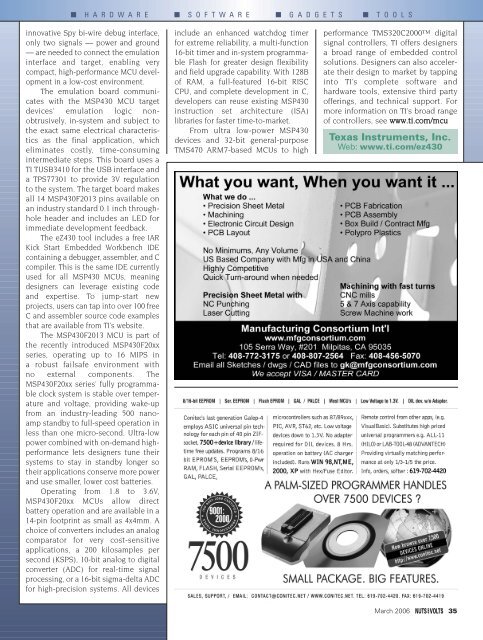Nuts & Volts
Nuts & Volts
Nuts & Volts
Create successful ePaper yourself
Turn your PDF publications into a flip-book with our unique Google optimized e-Paper software.
■ H A R D W A R E ■ S O F T W A R E ■ G A D G E T S ■ T O O L S<br />
innovative Spy bi-wire debug interface,<br />
only two signals — power and ground<br />
— are needed to connect the emulation<br />
interface and target, enabling very<br />
compact, high-performance MCU development<br />
in a low-cost environment.<br />
The emulation board communicates<br />
with the MSP430 MCU target<br />
devices’ emulation logic nonobtrusively,<br />
in-system and subject to<br />
the exact same electrical characteristics<br />
as the final application, which<br />
eliminates costly, time-consuming<br />
intermediate steps. This board uses a<br />
TI TUSB3410 for the USB interface and<br />
a TPS77301 to provide 3V regulation<br />
to the system. The target board makes<br />
all 14 MSP430F2013 pins available on<br />
an industry standard 0.1 inch throughhole<br />
header and includes an LED for<br />
immediate development feedback.<br />
The eZ430 tool includes a free IAR<br />
Kick Start Embedded Workbench IDE<br />
containing a debugger, assembler, and C<br />
compiler. This is the same IDE currently<br />
used for all MSP430 MCUs, meaning<br />
designers can leverage existing code<br />
and expertise. To jump-start new<br />
projects, users can tap into over 100 free<br />
C and assembler source code examples<br />
that are available from TI’s website.<br />
The MSP430F2013 MCU is part of<br />
the recently introduced MSP430F20xx<br />
series, operating up to 16 MIPS in<br />
a robust failsafe environment with<br />
no external components. The<br />
MSP430F20xx series’ fully programmable<br />
clock system is stable over temperature<br />
and voltage, providing wake-up<br />
from an industry-leading 500 nanoamp<br />
standby to full-speed operation in<br />
less than one micro-second. Ultra-low<br />
power combined with on-demand highperformance<br />
lets designers tune their<br />
systems to stay in standby longer so<br />
their applications conserve more power<br />
and use smaller, lower cost batteries.<br />
Operating from 1.8 to 3.6V,<br />
MSP430F20xx MCUs allow direct<br />
battery operation and are available in a<br />
14-pin footprint as small as 4x4mm. A<br />
choice of converters includes an analog<br />
comparator for very cost-sensitive<br />
applications, a 200 kilosamples per<br />
second (KSPS), 10-bit analog to digital<br />
converter (ADC) for real-time signal<br />
processing, or a 16-bit sigma-delta ADC<br />
for high-precision systems. All devices<br />
include an enhanced watchdog timer<br />
for extreme reliability, a multi-function<br />
16-bit timer and in-system programmable<br />
Flash for greater design flexibility<br />
and field upgrade capability. With 128B<br />
of RAM, a full-featured 16-bit RISC<br />
CPU, and complete development in C,<br />
developers can reuse existing MSP430<br />
instruction set architecture (ISA)<br />
libraries for faster time-to-market.<br />
From ultra low-power MSP430<br />
devices and 32-bit general-purpose<br />
TMS470 ARM7-based MCUs to high<br />
performance TMS320C2000 digital<br />
signal controllers, TI offers designers<br />
a broad range of embedded control<br />
solutions. Designers can also accelerate<br />
their design to market by tapping<br />
into TI’s complete software and<br />
hardware tools, extensive third party<br />
offerings, and technical support. For<br />
more information on TI’s broad range<br />
of controllers, see www.ti.com/mcu<br />
Texas Instruments, Inc.<br />
Web: www.ti.com/ez430<br />
March 2006 35

















